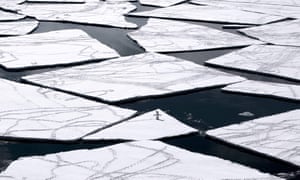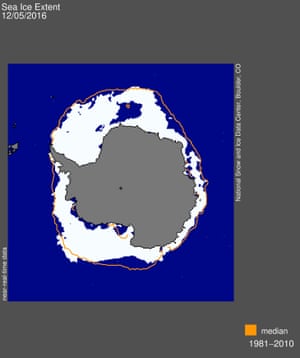Extract from The Guardian
‘Almost unprecedented’ event attributed to warm temperatures and winds, with some areas more than 20C (36F) warmer than usualScientists at the National Snow and Ice Data Center said that Arctic sea ice dipped for a short time in mid-November by around 50,000 sq km. Photograph: John Weller/AFP/Getty Images
Oliver Milman
@olliemilman
Wednesday 7 December 2016 08.08 AEDT
Both the Arctic and Antarctic experienced record lows in sea ice extent in November, with scientists astonished to see Arctic ice actually retreating at a time when the region enters the cold darkness of winter.
Warm temperatures and winds drove record declines in sea ice at both polar regions in November compared to the 38-year satellite record of ice extent for the month. Arctic sea ice extent averaged 9.08m sq km (3.51m sq miles) for November, which is 1.95m sq km (or 753,000 sq miles) below the long-term average from 1981 to 2010 for the month.
Scientists at the National Snow and Ice Data Center (NSIDC) said that Arctic sea ice extent dipped for a short time in mid-November, an “almost unprecedented” event. Sea ice shrank by around 50,000 sq km (19,300 sq miles) in this period, mainly in the Barents Sea.
This decline, which also occurred to a smaller degree in November 2013, removed an area of ice larger than Denmark from the Arctic at a time when sea ice is usually growing.
“It looks like a triple whammy – a warm ocean, a warm atmosphere, and a wind pattern all working against the ice in the Arctic,” said NSIDC director Mark Serreze.
In Antarctica, the average extent of sea ice in November was 14.54m sq km (5.61m sq miles), which is 1.81m sq km (699,000 sq miles) below the 1981 to 2010 average. This more than doubles the previous record low for the month of November.
A map from NSIDC showing the sea ice extent compared to the historical average from 1981 to 2010. Photograph: National Snow and Ice Data Center
Ted Scambos, the lead scientist at NSIDC, said: “Antarctic sea ice really went down the rabbit hole this time.” His colleague Walt Meier, who also works at Nasa, added: “The Arctic has typically been where the most interest lies, but this month, the Antarctic has flipped the script and it is southern sea ice that is surprising us.”
The Arctic’s record low, beating a mark set in 2012, was driven by unusually high temperatures over the Arctic Ocean, persistent winds that pushed ice north and a warm ocean. Areas of the Arctic have reached more than 20C (36F) warmer than usual, with an area of Russian Arctic forecast to be 33C (59F) warmer than normal on Thursday. 2016 is on track to be the warmest year on record globally.
Arctic sea ice usually grows over winter until it hits its maximum annual extent in March. However, this year has been notable for the lack of ice. “Typically sea ice begins to form in the fjords at the beginning of November, but this year there was no ice to be found,” said NSIDC scientist Julienne Stroeve, who assessed ice cover in Svalbard during November.
In the Antarctic air temperatures were 2-4C (3.6-7.2F) warmer than normal in November, with strong westerly winds helping disperse the sea ice pack. Several large bodies of open water have opened up within the sea ice formations around the Amundsen Sea and Ross Sea coasts.
The slump in November sea ice follows a persistent trend in the Arctic, where warming temperatures are causing problems for indigenous communities and wildlife including polar bears and walruses. This summer saw the second smallest ice extent on record, with the Arctic expected to be ice-free during summer within decades.
The loss of reflective sea ice amplifies the warming process by exposing the dark sea, which soaks up more heat which in turn helps melt more ice. The extra heat is also winnowing away the world’s glaciers, leading to sea level rise that places many of the world’s major cities at risk of flooding.


No comments:
Post a Comment